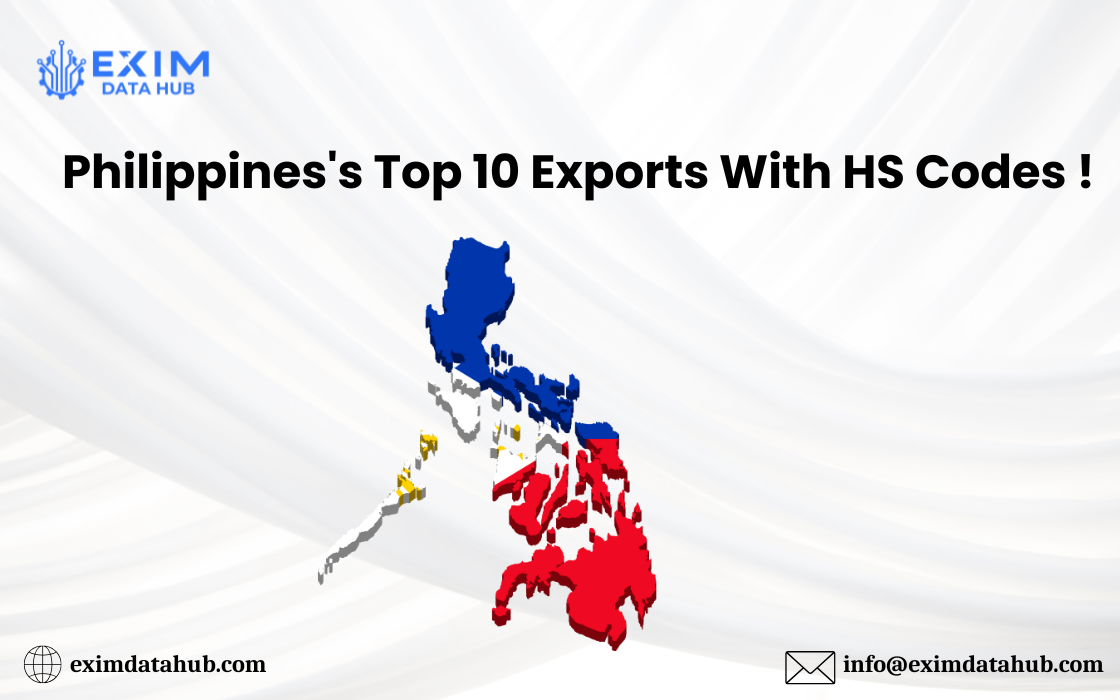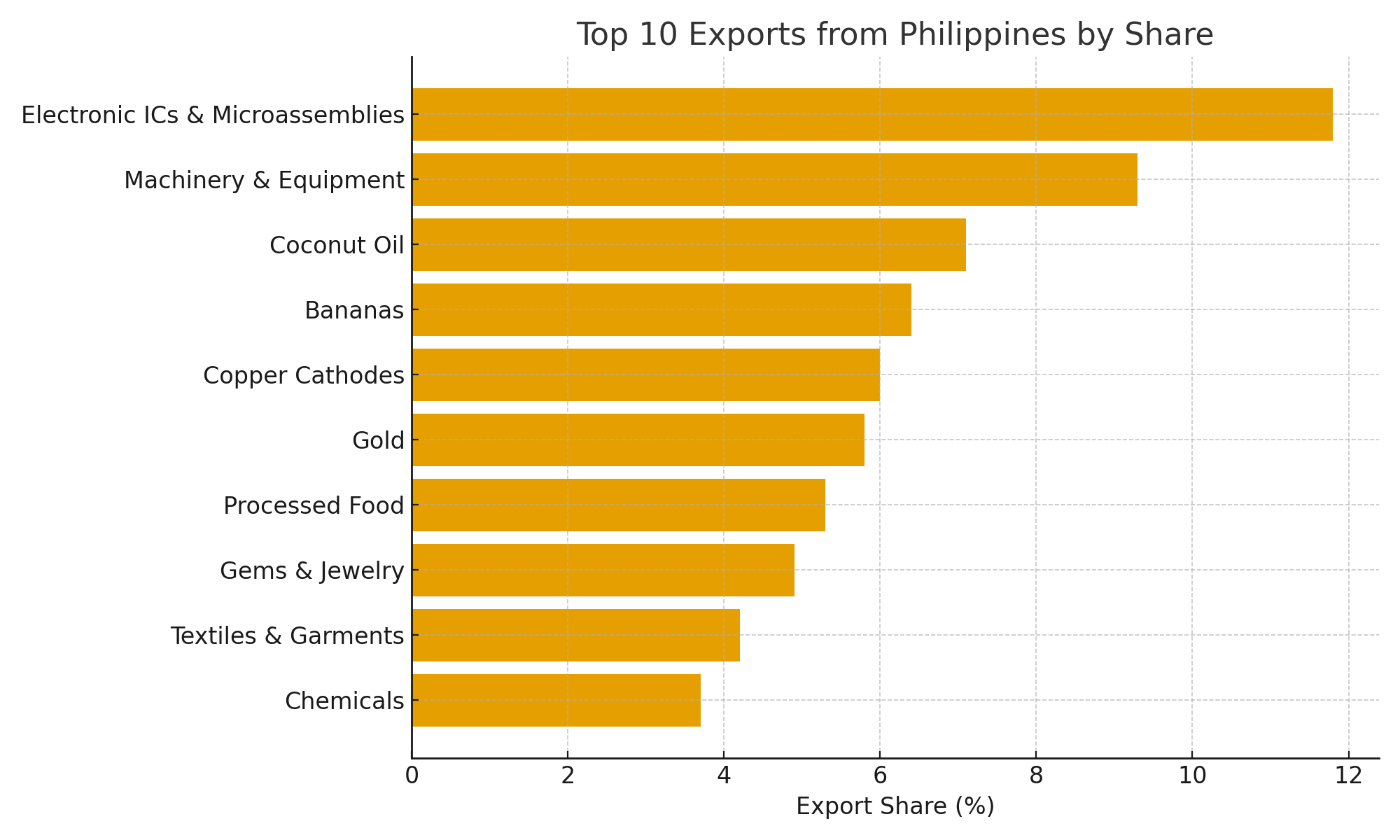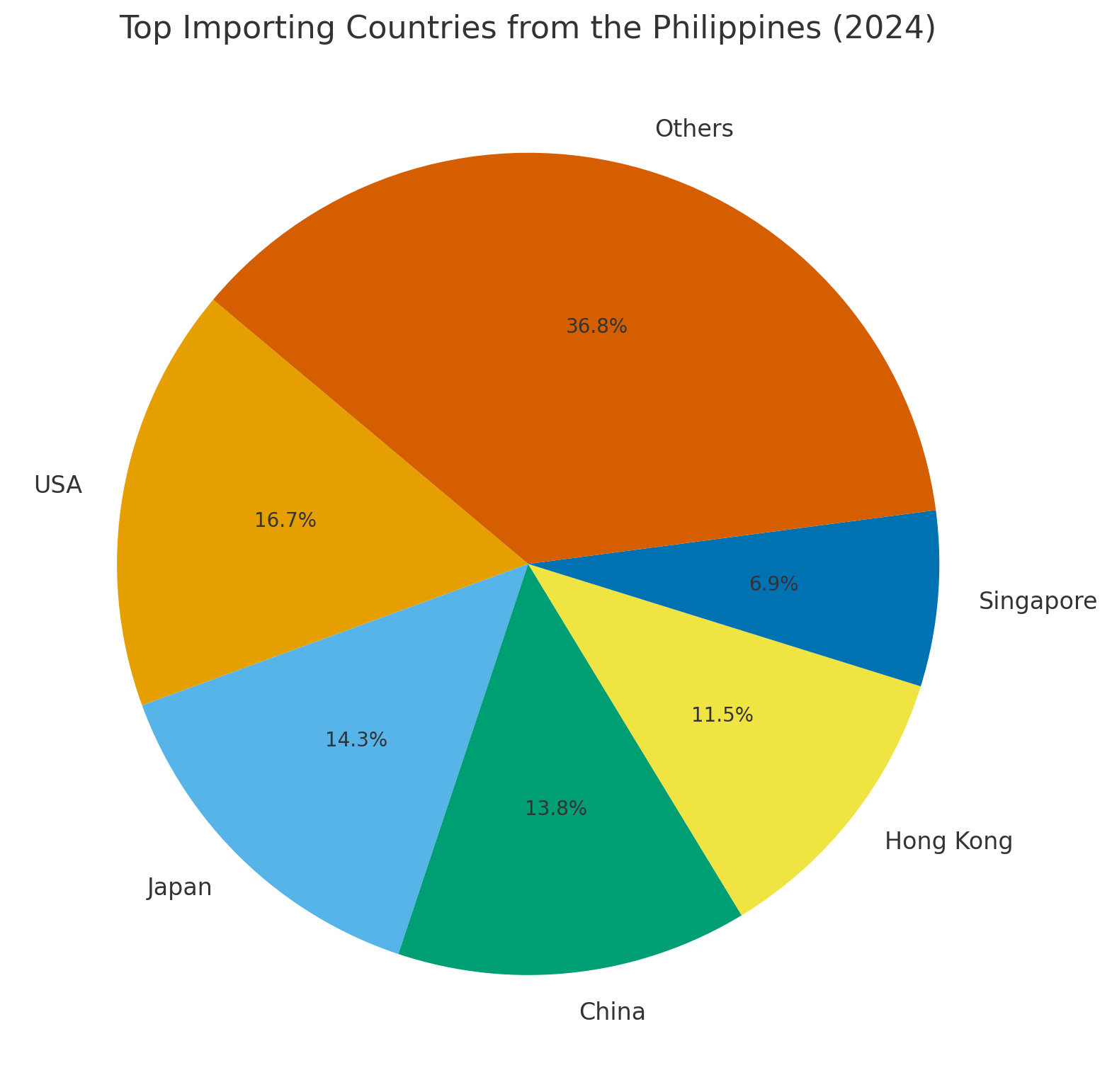
Discover where the Philippines is making global waves in trade.
Explore the latest trends, market data, and export insights for Philippine products shipping worldwide. This guide highlights export opportunities, demand forecasts, and essential HS code details to help businesses make confident and informed trade decisions.
🔹 Introduction
The Philippines continues to be a strong player in the global export market, driven by robust manufacturing, electronics, and agri-based industries. In 2024, total exports exceeded USD 71 billion, reflecting strong demand from countries like the United States, Japan, and China.
From semiconductors to coconut oil, the country exports a wide range of goods that meet both industrial and consumer needs. This article is designed to help exporters, traders, and consultants identify what’s hot in Philippine trade, which HS codes to track, and how to gain a competitive edge using tools like Exim Data Hub.
🔹 What Are the Philippines’s Top Exports?
➤ Electronics and semiconductors: Widely used in computers, mobile phones, and industrial systems. These account for more than 50% of total exports.
➤ Machinery and parts: Exported to automotive and manufacturing companies across Asia and the West.
➤ Coconut-based products: Like oil and copra meal—used in food, skincare, and health supplements.
➤ Bananas and fresh fruits: A popular export across Asia, especially to Japan and China.
➤ Textiles and garments: Known for quality and affordable pricing.
➤ Seafood and marine products: Tuna, shrimp, and seaweeds exported to premium markets.
➤ Metal and mineral ores: Including copper and nickel used in energy and tech industries.
These products are in high demand due to their quality, cost competitiveness, and steady production capacity.
🔹 Key Market Trends in Global Trade
| Market Driver | Description |
|---|---|
| ➤ Tech demand surge | Strong global demand for electronics due to 5G, AI, and smart devices |
| ➤ Organic food growth | Rise in demand for natural coconut oil and tropical fruits |
| ➤ Infrastructure expansion | Increased need for copper and nickel in electric vehicles and grids |

Use a bar chart comparing categories like Electronics, Agriculture, Minerals, etc. in billions USD.
Despite global trade headwinds, the Philippines maintained a 4.3% YoY growth in exports from Q2 2023 to Q2 2024. Electronics alone brought in over USD 38 billion, while agricultural exports like bananas and coconut oil hit a combined USD 6.5 billion.
The semiconductor sector saw a 7% increase, driven by demand from Taiwan, South Korea, and the US. Meanwhile, sustainable and organic goods—like virgin coconut oil—gained traction in niche markets like Europe and Australia.
Use a pie or line graph showing country-wise share (US, Japan, China, Singapore, etc.)
As demand for sustainable and high-tech goods rises, exporters who act fast can gain early-mover advantages in high-paying markets. Platforms like Exim Data Hub are helping traders tap into these opportunities through real-time analytics.
🔹 Top Exporting Countries for These Products
| Country | Share of Imports |
|---|---|
| ➤ United States | 16.7% |
| ➤ Japan | 14.3% |
| ➤ China | 13.8% |
| ➤ Hong Kong | 11.5% |
| ➤ Singapore | 6.9% |
These countries consistently import semiconductors, electronics, fruits, and marine products. The US and Japan prefer high-quality electronics and sustainable food products, while China and Hong Kong lead in fresh fruit and mineral imports.
Trade preferences are shifting, too: Europe is becoming a growing destination for organic coconut products and seaweed snacks. Exporters should monitor these shifts closely to adjust packaging, compliance, and logistics strategies.
🔹 Opportunities for Exporters
➤ Premium pricing with certifications like USDA Organic, Halal, and HACCP
➤ Tapping health-conscious markets in North America and Europe
➤ Niche positioning in cosmetics and nutraceuticals
➤ Sustainable mining exports with traceable sourcing and ESG compliance
➤ Leveraging free trade agreements (FTAs) with Japan and ASEAN
🔹 HS Codes for the Philippines’s Top Exports
Here are 4 key HS Codes covering major export categories:
➤ 85423100 – Electronic integrated circuits (processors & controllers)
➤ 15131100 – Coconut oil (virgin)
➤ 08039020 – Bananas (fresh, excluding plantains)
➤ 74031100 – Copper cathodes and sections of cathodes
Understanding and using the correct HS code is crucial for customs clearance, tariff calculations, and trade reporting. If you’re unsure which code fits your product, you can request tailored HS code data from Exim Data Hub based on your export category. Additionally, for reference, you can explore the WCO HS Nomenclature guidelines to better understand how international classification works.
🔹 How Exim Data Hub Helps Exporters
| Feature | Exporter Benefit |
|---|---|
| ➤ HS Code Intelligence | Accurate classification to reduce border delays and fines |
| ➤ Buyer/Seller Insights | Find real importers and exporters with contact details |
| ➤ Forecast Reports | Anticipate demand changes with quarterly data |
| ➤ Tariff Trends | See real-time duty updates for any country |
Exporting doesn’t have to be complex. With Exim Data Hub, you get clarity and control—no more guesswork. Whether you’re shipping bananas to Japan or semiconductors to Singapore, our platform helps you do it smarter, faster, and with full data confidence.
🔹 Conclusion
The Philippines has established itself as a reliable supplier of both high-tech and natural products in global markets.
➤ Exporters must monitor trends like tech demand, organic food growth, and infrastructure projects
➤ Use correct HS codes and track changing tariff rules for smooth delivery
➤ Platforms like Exim Data Hub can simplify everything from market entry to contact discovery
Want to export smarter? Use Exim Data Hub to stay ahead in global trade and discover new buyers before your competitors do.
🔹 Frequently Asked Questions (FAQ)
Q1: Is certification required for exporting coconut oil or seafood from the Philippines?
Yes. Most markets require HACCP, Halal, Organic, or ISO certifications depending on the commodity.
Q2: How large is the current market for electronics exports?
Electronics represent over USD 38 billion in exports, accounting for more than 50% of the country’s total export value.
Q3: How can Exim Data Hub help with documentation and compliance?
We provide end-to-end support—from HS classification to required docs per country—so you stay fully compliant.
Q4: What’s the easiest product to start exporting from the Philippines?
Bananas, coconut oil, and processed seafood are great entry points due to consistent demand and simpler documentation.








